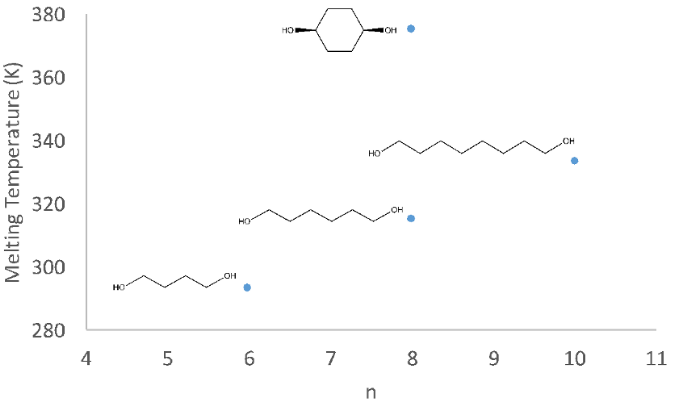How is the melting point of a molecular compound affected by its structure?
What is this experiment about?

Students predict how various factors affect the melting point, and make connections to enthalpy and entropy of fusion. This dry lab has students explore the NIST Chemistry Webbook database to examine a variety of organic molecules. Students discover that they must look at multiple structural properties to obtain a full understanding of the melting point behavior. Students should be familiar with concepts of enthalpy and entropy and a basic sense of how they apply to molecular structure.
What do students do?
Students tend to have a preconception that melting is very similar to boiling—that is, melting point is determined exclusively by IMFs. In this experiment, students consider various sets of molecules designed to allow them to discover that they will need to take into account additional factors. Students will predict the effects of flexibility, polarity, molecular size, and symmetry on melting point, and explain how these parameters affect the enthalpy and entropy of fusion. Students work together to research values and model data, and they periodically report out to the class. Note that this experiment is a dry lab activity–students find data on the NIST Chemistry Webbook (and also use computational modeling software to visualize the molecules). In post-experiment questions, students can apply what they’ve learned to design molecules with high or low melting points. The experiment can be completed in as little as one lab period, including some work outside of class.
What equipment and supplies will you need?
Electronic devices with access to the internet (to look up data on NIST Chemistry Webbook). The molecular modeling will require Spartan, webMO, or another similar program. (A plastic model kit may also work, but verify that it is flexible enough to build cubane, with its high angle strain).
What makes this experiment a physical chemistry experiment?
Students consider how melting point is impacted by molecular parameters, and, consequently, make the connection between melting point and enthalpy and entropy of fusion. They see the importance of examining a broad range of molecules and the significance that outliers in the data have in developing a full sense of the connections between molecular structure and behavior.
And what makes it a POGIL-PCL experiment?
Students make predictions about the connection between melting point and molecular structure, share and interact with other students to build a full set of data testing their predictions, model the data with structural parameters to draw conclusions, and demonstrate their understanding of the connection between melting point, enthalpy, and entropy beyond the simple models from previous classes.
Reference
Lead Author: John Hagan, California Polytechnic State University
The Student Handout and Instructor’s Handbook with implementation details, sample data, and expected answers is available through the POGIL-PCL project.
Highlight author: Diane Miller, Seton Hill University